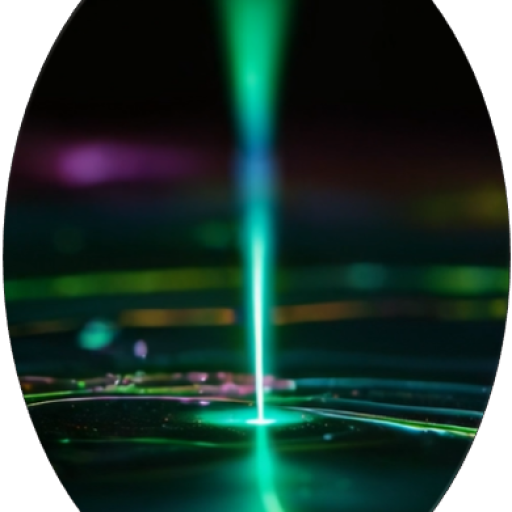Focused Ion Beam (FIB) Milling: Precision at Every Scale
FIB milling is a cornerstone of nanoscale material removal, offering unparalleled versatility for applications ranging from high-resolution structuring to large-volume material removal. For the finest features, Helium Ion Beams (He-FIB) deliver atomic-scale precision, enabling intricate milling tasks with sub-nanometer accuracy. This is particularly valuable for applications in advanced microscopy sample preparation, defect analysis, and creating delicate nanostructures. When scaling up to largest volumes, Plasma FIB (pFIB) systems excel. By using heavier ions such as Xenon or Argon, these systems achieve significantly higher material removal rates, making them ideal for tasks like preparing large cross-sections or fabricating microdevices with deep trenches and complex geometries. Between these extremes, Gallium FIB (Ga-FIB) platforms offer a balanced solution, combining high precision and versatile material compatibility. As the most widely used FIB technology, Ga-FIB systems are well-suited for routine nanoscale milling, offering a reliable and accessible choice for many scientific and industrial applications.
Literature
Roadmap for Focused Ion Beam Technologies; K. Höflich et al.; Appl. Phys. Rev (2023), 10, 041311.
Review Article: Advanced Nanoscale Patterning and Material Synthesis with Gas Field Helium and Neon Ion Beams; M.G. Standford et al.; J. Vac. Sci. Technol. B (2017), 35, 030802.
Inverse Modeling of FIB Milling by Dose Profile Optimization; S. Lindsey et al.; Nuclear Instruments and Methods in Physics Research B (2014), 341, 77.
Directing Matter: Toward Atomic-Scale 3D Nanofabrication; S. Jesse et al.; ACS Nano (2016), 10, 6, 5600.
FIBIE: Enhanced Precision Through Chemical Synergy
Focused Ion Beam Induced Etching (FIBIE) takes FIB milling to the next level by combining ion bombardment with reactive precursor gases. This approach significantly increases material removal rates and enables advanced selective etching by tailoring the gas chemistry to the material being processed. FIBIE is particularly effective for applications requiring material selectivity (often at larger scales), such as exposing buried layers or differentiating between multi-material interfaces. Its ability to focus removal only on targeted areas minimizes damage to surrounding structures, a key advantage over traditional physical milling. By reducing physical sputtering contributions, FIBIE also generates cleaner cuts and smoother surfaces, making it ideal for tasks like microelectronic device repair or advanced photonics.
Literature
Roadmap for Focused Ion Beam Technologies; K. Höflich et al.; Appl. Phys. Rev (2023), 10, 041311.
Directing Matter: Toward Atomic-Scale 3D Nanofabrication; S. Jesse et al.; ACS Nano (2016), 10, 6, 5600.
Nanofabrication Using Focused Ion and Electron Beams: Principles and Applications; I. Utke, S. Moshkalev S., P. Russell P.; Oxford: Oxford University Press (2012)
FEBIE: Non-Invasive Precision for Sensitive Applications
Focused Electron Beam Induced Etching (FEBIE) offers a gentler alternative to FIBIE by relying on electron beams instead of heavy ions to activate the etching process. This shift eliminates the physical sputtering effects associated with ion bombardment, preserving the surrounding material and enabling superior control over the removal process. FEBIE is especially advantageous whenever implantation free material removal is needed but also applies for heat-sensitive materials or structures that require minimal thermal and mechanical impact. Another major benefit of FEBIE is its ability to etch with high selectivity and accuracy, particularly for nanostructures and intricate geometries. However, FEBIE typically achieves slower removal rates and is best suited for applications prioritizing fine detail over high throughput. Despite this, FEBIE’s non-invasive nature makes it a preferred choice for delicate materials, such as polymers, semiconductors, and biological samples, where damage minimization is critical.
Literature
Charged Particle Induced Etching and Functionalization of Two-Dimensional Materials; C. Elbadawi et al.; ECS J. Solid State Sci. Technol. (2022), 11, 035011.
Advances in Gas-Mediated Electron Beam-Induced Etching and Related Material Processing Techniques; M. Toth; Appl. Phys. A (2014) 117:1623
Roadmap for Focused Ion Beam Technologies; K. Höflich et al.; Appl. Phys. Rev (2023), 10, 041311.
Nanofabrication Using Focused Ion and Electron Beams: Principles and Applications; I. Utke, S. Moshkalev S., P. Russell P.; Oxford: Oxford University Press (2012)
